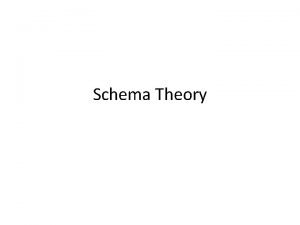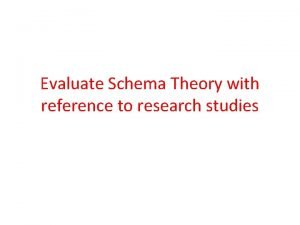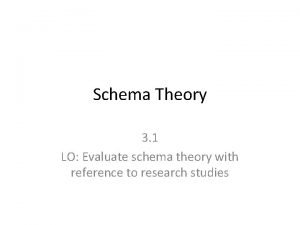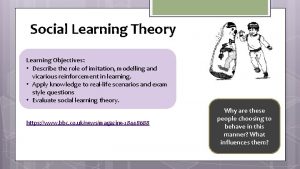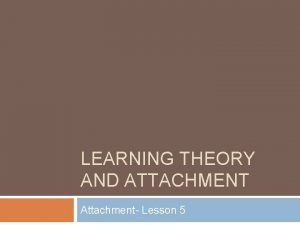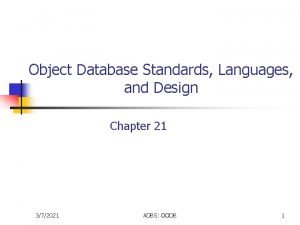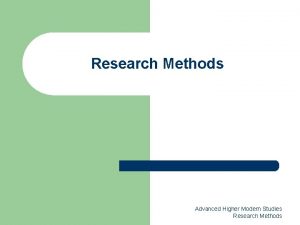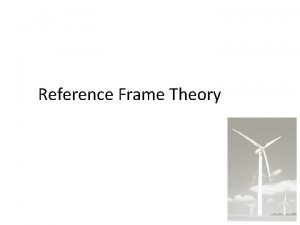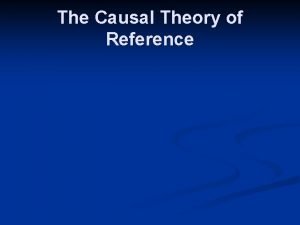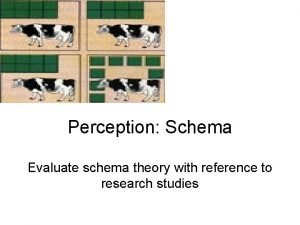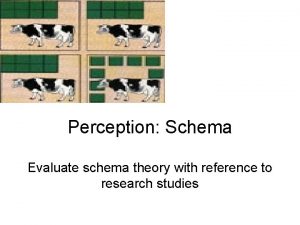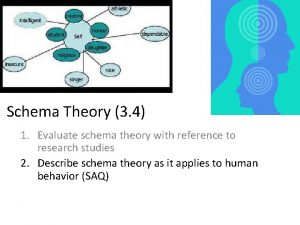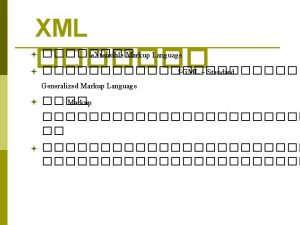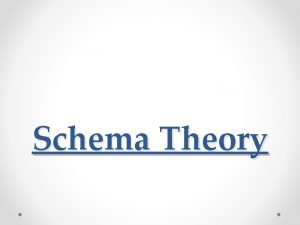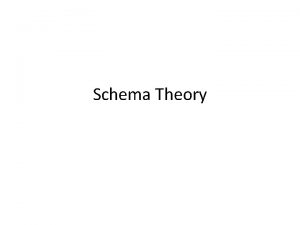Evaluate Schema Theory with reference to research studies
















- Slides: 16

Evaluate Schema Theory with reference to research studies

SCREAMA FOR YOUR SCHEEEEMA • A schema is a mental representation of knowledge stored in the brain. • It is a network of knowledge, beliefs and expectations about particular aspects of the world. Evaluate Schema Theory with reference to research studies

How do we process schemas? • It is to a large extent automatic (we do not pay attention when it is happening). • It involves information from two sources…. . Evaluate Schema Theory with reference to research studies

Bottom-Up Processes • Information from our sensory systems • We use the features on the object itself to build a perception. • Takes longer that top-down but is more accurate. Evaluate Schema Theory with reference to research studies


i cdnuolt blveiee taht I cluod aulaclty uesdnatnrd waht I was rdanieg. The phaonmneal pweor of the hmuan mnid, aoccdrnig to a rscheearch at Cmabrigde Uinervtisy, it dseno’t mtaetr in waht oerdr the ltteres in a wrod are, the olny iproamtnt tihng is taht the frsit and lsat ltteer be in the rghi t pclae. The rset can be a taotl mses and you can sitll raed it whotuit a pboerlm. Tihs is bcuseae the huamn mnid deos not raed ervey lteter by istlef, but the wrod as a wlohe. Azanmig huh? yaeh and I awlyas tghuhot slpeling was ipmorantt! if you can raed tihs forwrad it.

Top-Down Processes • Information stored in memory. • We perceive by filling the gaps in what we sense. • I _ant ch_co_ate ic_ cr_am. • Based on our experiences and schemas. • If you see many old men in glasses, you are more apt to process a picture of an old man (even when you may be in error).

One example is Gender Schema • Societies beliefs about the traits of males and females. • Causes gender schemas. • Which influences… – Processing of social information. – Self-esteem (our behavior must fit in to gender schema) How does could the Bartlett study (1932) be used to explain gender schemas?

Brewer and Treyens (1981) Experiment of memory of objects in a room Aim: • To investigate whether people’s memory for objects in a room (office) is influenced by existing schemas about what to expect in an office.

Brewer and Treyens (1981) Experiment of memory of objects in a room Procedure • Participants were 30 university students, who arrived individually to the laboratory and were asked to wait in an office containing objects (desk typewriter, coffee pot etc…)

Brewer and Treyens (1981) Experiment of memory of objects in a room • There were also other objects that did not conform to the office schema (skull, piece of bark, pair of pliers etc. . ) • After waiting for some time, participants were taken out of the office and asked to write down everything they could remember from the room.

Brewer and Treyens (1981) Experiment of memory of objects in a room Results • Most participants recalled the schematic objects (desk, typewriter) • Some participants reported things that would be expected in office but were not present (phone, books) • Many participants also recalled the skull (not as predicted by schema theory)

Brewer and Treyens (1981) Experiment of memory of objects in a room Evaluation • The study confirms schema theory (and reconstructive memory), but once again it was a controlled laboratory environment. • The study used deception, but they were debriefed and not harmed. • Sample bias with only university students.

How can schemas affect memory? • People remember the meaning (gist) of something and not the actual wording (Bartlett) • People use stored knowledge to make sense of incoming info (topdown). If the info is incomplete, they fill in the gaps (reconstructive memory) (Bartlett).

How can schemas affect memory? • People tend to ignore information not in line with their schemas (aschematic information). This leads to bias (Darley and Gross and Brewer and Treyens ) • People tend to focus on information that is in line with their schema. This can result in confirmation bias (Darley and Gross and Brewer and Treyens ).

Strengths and Weaknesses of Schema Theory Strengths Weaknesses • Schema theory has proven useful in explaining many cognitive processes (memory, reasoning etc. . ) • Can be used to explain phenomenon such reconstructive memory and stereotyping. • Cohen (1993) argues that schema theory is too vague to be useful and never truly explains where they come from. • Focuses too much on inaccuracies of memory where people are still accurate most of the time.
 Gender schema theory evaluation
Gender schema theory evaluation Evaluate schema theory with reference to research studies
Evaluate schema theory with reference to research studies Evaluate schema theory with reference to research studies
Evaluate schema theory with reference to research studies Evaluate
Evaluate Exercise #1 – evaluate case studies answer key
Exercise #1 – evaluate case studies answer key Paradigm shift from women studies to gender studies
Paradigm shift from women studies to gender studies Social learning theory strengths and weaknesses
Social learning theory strengths and weaknesses Outline and evaluate the learning theory of attachment
Outline and evaluate the learning theory of attachment Outline bowlby's theory of attachment 6 marks
Outline bowlby's theory of attachment 6 marks Reference node and non reference node
Reference node and non reference node Reference node and non reference node
Reference node and non reference node Mapping an eer schema to an odb schema
Mapping an eer schema to an odb schema Advanced higher modern studies understanding standards
Advanced higher modern studies understanding standards Market segmentation gcse
Market segmentation gcse Early studies led to the development of the cell theory
Early studies led to the development of the cell theory Dqo transformation
Dqo transformation Causal theory of reference
Causal theory of reference

